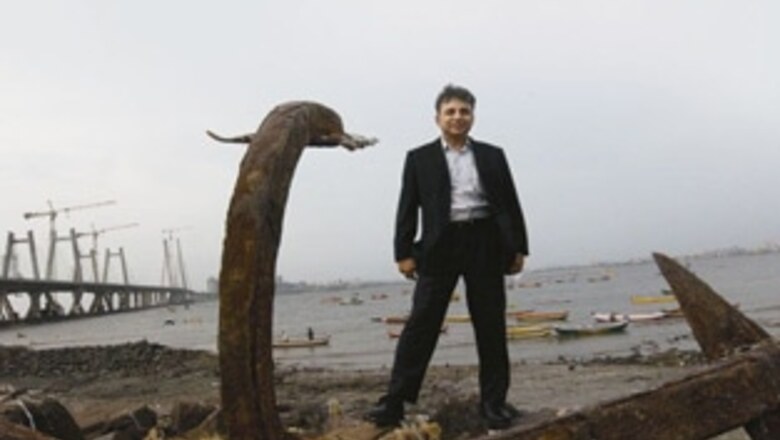
views
Sample this conversation from the book, Yes Minister, between Dr Cartwright, a bureaucrat, and Right Honourable Jim Hacker, Minister, Department of Administrative Affairs.
“I’m a professional economist,” he explained. “Director of Local Administrative Statistics.”
“So you were in charge of Local Government Directorate until we took over?”
He smiled at my question.
“Dear me, no.” He shook his head sadly, though apparently without bitterness.
“No, I’m just Under Secretary rank. Sir Gordon Reid was the permanent secretary. I fear that I will rise no higher.”
I asked why not.
He smiled. “Alas! I’m an expert.”
They say all analogies are imperfect, yet the reason 45-year-old Shailesh Pathak resigned from the prestigious Indian Administrative Service (IAS) in 2007, bears an uncanny resemblance to Dr Cartwright’s last comment.
“The reason [to resign] was simple. I wanted to spend the rest of my life in infrastructure financing and execution. And I realised that being a generalist kind of a job, the IAS could not permit me to do that,” says Pathak.
Pathak, a 1990 batch officer, graduated from Indian Institute of Management (IIM), Calcutta, in 1986. He spent a lot of time associated with the infrastructure sector during his stint with the government. He served as Managing Director of the Madhya Pradesh State Infrastructure Development Corporation as well as the Secretary in the Public Works Department (PWD). In 2000, he was selected as one of the 15 emerging leaders in India for the Eisenhower Fellowship and went on to study infrastructure and governance in the US. Later, in 2003, he visited the European Union to study their institutions.
Currently he is the senior director at ICICI Venture in Mumbai and heads the Infrastructure division.
Lobbying for effectiveness
Pathak’s case epitomises a basic problem with the way government-sponsored projects are administered: Leadership positions are typically assigned based on seniority, not knowledge of the sector. As a result, actual implementation of projects is the weakest aspect of governance in India.
A recent McKinsey report titled Building India: Accelerating Infrastructure Projects also points out that it is not financing, but poor implementation that is the real hurdle in India’s infrastructure growth.
And that is what Pathak and a group of likeminded people in the civil services hope to change.
Before he quit the civil services, Pathak formed IIM-G, an informal grouping of ‘IIM graduates in government services’. It represents a group of people with a proven track record and is a resource available within the government for projects where effective delivery is important. Today it has over 100 members.
“IIM-G just hopes that the selection mechanism will become more output oriented,” says Bharat Salhotra, a 1988 batch officer of the Indian Railway Accounts Service and an alumnus of IIM Calcutta and the Sloan School of Management. He is currently General Manager (Finance) and the Chief Information Officer for the Dedicated Freight Corridor Corporation (DFCCIL) in New Delhi.
However, both Pathak and Salhotra are quick to explain that IIM-G is not asking for any special assignments for its members. It is only making a case for looking beyond seniority and hierarchy when appointing heads of infrastructure projects, both social and physical.
They believe that ideally one should be allowed to have a crack at any such top job, irrespective of whether one is from within the government or outside it. That idea comes from Pathak’s experience during the Eisenhower Fellowship when he witnessed “tremendous mobility between business, government, and academia in the US.”
But such a radical change is not going to happen overnight. “So the logical way is to begin by throwing open competition from within the government, irrespective of the service and batch. Once this gains ground, at a later stage, even people from the private sector could be allowed to compete,” says Pathak.
B S Baswan, director of the Indian Institute of Public Administration (IIPA) and a 1967 batch IAS officer welcomes such a move. “It’s really not an anathema to the government. It is true that our delivery systems are weak and there are flaws in our public policy,” he says.
What is wrong with the current setup?
Salhotra cites the case of the much vaunted Dedicated Freight Corridor (DFC) which was conceptualised in 2004 and the initial deadline was 2012-13. However, the revised completion date has shifted to 2017-18. Costs have gone up so much that the internal rate of return is near negative. According to his estimates, each day’s delay costs the DFC close to Rs. 70 crore.
PAGE_BREAK
“Such delays happen in practically every project, be it highways, ports or power. Why? You cannot start a project of this scale, involving Rs. 50,000 crore, without first spending enough time on the drawing board. I am pretty certain that nobody from IIM would have advocated this kind of philosophy,” says Salholtra.
A flawed system
IIM-G members play down the hurdle posed by so-called excessive governmental procedures in achieving targets. They believe that the right man will find a way out while the unwilling one will hide behind the same procedures.
In their view it is a flawed system of performance appraisal where seniority scores over merit, and a lack of accountability allows delays to go unpunished.
That’s a view shared by the Administrative Reforms Commission (ARC) headed by the union law minister, M Veerappa Moily. “The assurance of a secure career path is the… main shortcoming because it tends to discourage initiative by reducing competition and abets complacence…. It is difficult not only for highly qualified and competent persons outside the government, but also for high performers from other branches of the civil services to get selected for top positions in government,” states the ARC’s 2008 report, Refurbishing of Personnel Administration.
Bipul Kiran Singh, CEO of Torque Communications, a New Delhi-based public relations firm (he is an IIM graduate who resigned from the Indian Information Service in the mid 1990s), feels that unlike the private sector, it is difficult to define profit, or a similar metric, in most government organisations. As a result, performance appraisal is not as sharp and government officials are not accountable for delays. On the flip side, the system gives little reward for those who push the envelope and innovate.
Singh gives the example of N P Singh, a Karnataka cadre IAS officer who was singularly instrumental in bringing the Delhi Metro Rail project--first conceptualised in 1985--back to life in 1994-95. “Today he is faceless. Nobody knows about his contribution. If he was in the private sector, he would have been a hero,” says Singh.
The situation is made even worse with the transferable nature of the job.
Salhotra recounts his experience, from 1994 to 2001, as the Director of a World Bank supported Long Range Decision Support System Group, which essentially was a software to help Indian Railways prioritise investments over the next 20 years. But even after its successful completion, the software hasn’t really made
much difference.
“That’s the tragedy. The system in the government is such that one has to move on and the team just withered away and the tools have got obsolete over time,” rues Salhotra.
The IIM-G advantage
Vini Mahajan, Joint Secretary at the Prime Minister’s Office and a 1987 batch IAS officer, perhaps best embodies the skill set that an IIM-G member brings to the table. Her background and understanding allowed her to create the templates for Public Private Partnership (PPP) mode of infrastructure development, during her stint as the Managing Director of the Punjab Infrastructure Development Board (PIDB). The templates were later adopted by the Government of India.
She put in place automatic and transparent penalties since she understood that terminating a contract for any and every infringement would actually hurt public interest in the longer term by turning away investors. She introduced the
concept of having an independent regulator to avoid conflict of interest within
the government.
“All these concepts were relatively new to government. But now they have become part of the central government’s approach as well,” says Mahajan.
So how far has IIM-G succeeded in getting through its message in the corridors of power?
For starters, the Sixth Pay Commission, which gave its final report in March 2008, has included the IIM-G proposals almost verbatim. This is the first time a pay commission has recommended for the senior administrative posts to be filled by a new selection process that will open such posts to all eligible central government officers and not remain restricted to only one service.
The Pay Commission has also recommended that the government should open all the posts which require technical or specialised knowledge to eligible candidates, regardless of whether they are from within or outside the central services.
The ARC had earlier recommended lateral entry from the private sector. The Cabinet Secretary is now working on finding better selection methods and ways to tap the professional skills available within the government after the IIM-G made a presentation in February this year.
Pathak had left the civil services hoping that if he wanted, he would be able to come back in the future through the lateral entry route. It appears that may be possible after all.




















Comments
0 comment